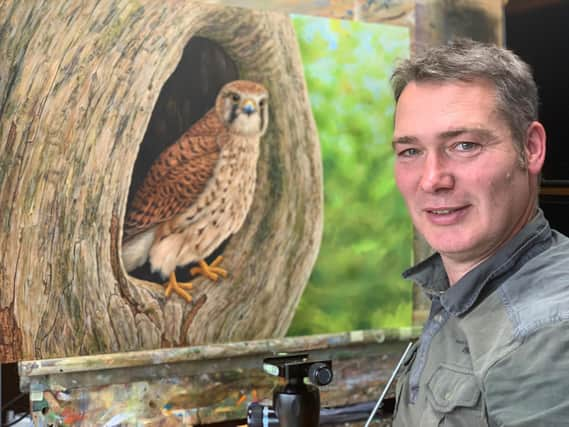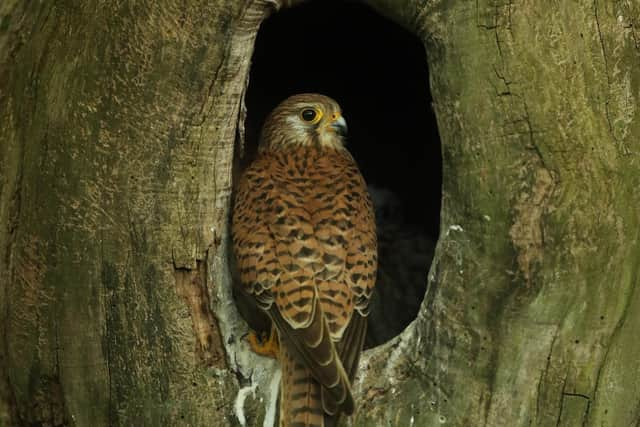Wildlife artist Robert Fuller captures a "plucky" female kestrel on canvas after seeing her fight to protect her nest and chicks


Painted in acrylics, it’s a portrait of a particularly plucky female whose life I have followed closely on my wildlife cameras this season.
She and her mate appeared in my garden late last winter and began an intense courtship.
Advertisement
Hide AdAdvertisement
Hide AdI was delighted when they went on to inspect the array of nest boxes I have here. The male led the search, inspecting suitable sites and then calling the female in to ask for her approval.


It was particularly pleasing to see them because my resident kestrel, a male that had lived and bred here for over a decade, disappeared last year after his mate died unexpectedly whilst brooding their chicks.
This new pair brought renewed promise and I was delighted when they picked out a nest box I had made myself out of an old ash stump.
But then a jackdaw launched a challenge for the site. Thankfully, the female kestrel responded promptly, squawking angrily and leaping at the bird, claws poised for attack.
Advertisement
Hide AdAdvertisement
Hide AdThis was the first I had seen of this kestrel’s feisty nature and as it turned out this tenacity and bravery were qualities she was to call upon again and again as the season unfolded.
I watched on a screen linked to hidden cameras as she returned to her nest, plumped up her feathers and determinedly dug a shallow scrape into the bottom of the nest.
This small depression is all that a kestrel will do in preparation for the eggs that soon followed.
But shortly after she had laid her first egg, a tawny owl entered the box. I watched horrified as the tawny flew straight at the kestrel, ignoring her warning screeches.
Advertisement
Hide AdAdvertisement
Hide AdThe kestrel braced her wings against the sides of the nest entrance to try to prevent the owl from entering, but he barged past her and they duelled right on top of the kestrel’s only – precious – egg.
The female kestrel evicted this intruder – digging her long talons into the owl’s back and screeching at it as it flew off – but I was worried the egg would not hatch out after such a rumble.
Sadly, the tawny owl continued to harass the kestrel, night after night, and before long the stress was beginning to show on the incubating falcon.
Although she laid a further two eggs in the box, she began to spend more and more time away from her clutch and it wasn’t long before I spotted her on another camera inspecting a second potential nest site.
Advertisement
Hide AdAdvertisement
Hide AdOne time while she was away from her clutch, a jackdaw raided the nest, cracked open one of her eggs with its beak and started eating the contents.
The male kestrel returned and quickly chased the jackdaw off before it destroyed the rest of the clutch. But it was heartbreaking to watch on the screens as he inspected the broken egg.
Carefully, he removed the pieces of eggshell from the nest. Kestrels will discard broken eggs to keep the nest clean and reduce the risk of infection.
Despite these two tragedies the female kestrel continued to lay another three beautiful, speckled eggs, each appearing at two-day intervals.
Advertisement
Hide AdAdvertisement
Hide AdBut her battle to protect her nest from the tawny owl continued.
Tawny owls are well known for their territorial disputes, and this one was a real bully – he seemed determined to rule the valley.
The kestrel put up a good fight, but yet another egg was lost when the tawny owl again forced its way into the nest.
During this scuffle I saw the tawny owl drag the female kestrel screeching out of the box and I became worried for her safety.
I was also afraid the eggs would get cold.
Advertisement
Hide AdAdvertisement
Hide AdThankfully she returned and both kestrels bravely continued to share the job of incubating their clutch of, now five, eggs.
I felt very proud of them for carrying on, where many birds by now would have abandoned this nest and found somewhere safer, and it was heartening to hear them on my microphone chatter to one another as though swapping notes as they switched incubation duties.
I went on to watch on the screens in my studio as all five of the remaining eggs successfully hatched.
It was so exciting to see the first chick emerge, its down still wet and eyes barely open.
Advertisement
Hide AdAdvertisement
Hide AdSurprisingly, this chick was already responsive just moments after hatching. I watched it, its mouth gaping, as it swallowed down tiny titbits of food offered to it by the female.
This female turned out to be an excellent mother. She was very patient, always feeding each chick in turn, making sure not to exclude the weaker ones.
At times, however, her inexperience showed through – once I watched her actually topple over as she tried to fit all five chicks under her breast.
The male helped out, bringing in a wide variety of prey, including, unusually, lizard – which is a protein-packed treat for a growing kestrel family.
Advertisement
Hide AdAdvertisement
Hide AdHe, too, is clearly a new dad and the first time I saw him brood the chicks he was very unsure of himself, all ‘talons and thumbs’ as he worked out what to do.
All five kestrel chicks grew fast under the care of their doting parents and within a week had turned from helpless creatures unable to hold up their heads to a noisy rabble squabbling over food!
As I watch them now, just fledged, practising their flights in the trees near my art studio, I think back to how lucky they are that their mother carried on in spite of all the attacks on the nest she endured.
And I hope I have captured some of her courageous character in her portrait, which is now hanging in pride of place in my newly re-opened gallery.